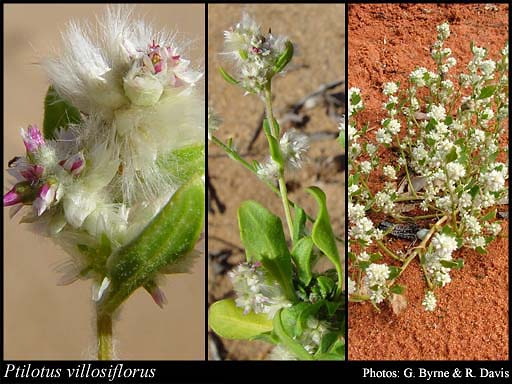- Reference
- Fragm. 3:125 (1862)
- Conservation Code
- Not threatened
- Naturalised Status
- Native to Western Australia
- Name Status
- Current
Decumbent to ascending annual or perennial, herb, 0.05-0.3 m high. Fl. white-pink, Jul to Dec. Sand. Coastal dunes & beaches.

Scientific Description
Annuals, stems several, more or less erect, glabrescent or glabrous, with nodose hairs. Leaves present, 5-55 mm long, 2-18 mm wide, glabrescent or glabrous, with nodose hairs; basal rosette absent; cauline leaves alternate. Spikes white, ovoid, hemispherical or spherical, clustered, with densely arranged flowers. Bracts 2.8-3.4(-4.2) mm long, colourless, hairy, awned or mucronate, with an obscure midrib. Bracteoles 3.7-4.5(-5) mm long, colourless, hairy, awned or mucronate, with an obscure midrib. Outer tepals 3-5 mm long, entire. Inner tepals 2.8-4.8 mm long, glabrous within. Style 0.3-0.4 mm long, straight, centrally fixed to ovary. Seeds 1.2 mm long, glossy, brown. Distribution: South West, Northern and Eremaean Botanical Region; IBRA regions: Dampierland.
Distribution
- IBRA Regions
- Carnarvon, Dampierland, Geraldton Sandplains, Pilbara, Yalgoo.
- IBRA Subregions
- Cape Range, Chichester, Edel, Geraldton Hills, Pindanland, Roebourne, Wooramel.
- IMCRA Regions
- Central West Coast, Ningaloo, Pilbara (nearshore), Pilbara (offshore), Shark Bay, Zuytdorp.
- Local Government Areas (LGAs)
- Ashburton, Broome, Carnarvon, Exmouth, Greater Geraldton, Karratha, Northampton, Port Hedland, Shark Bay.